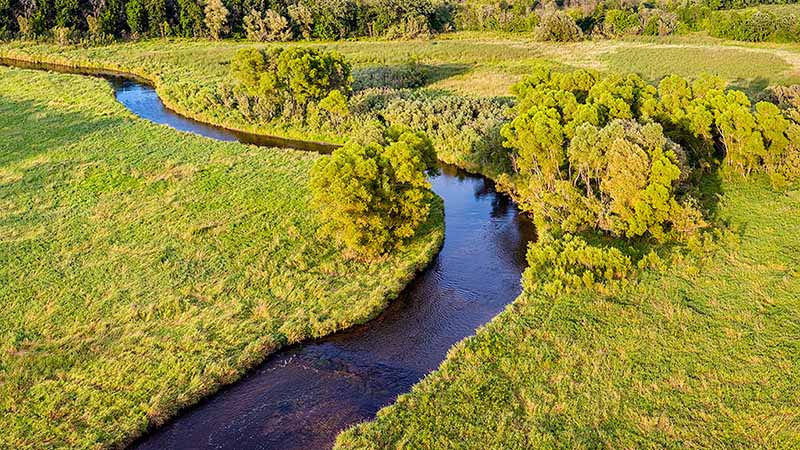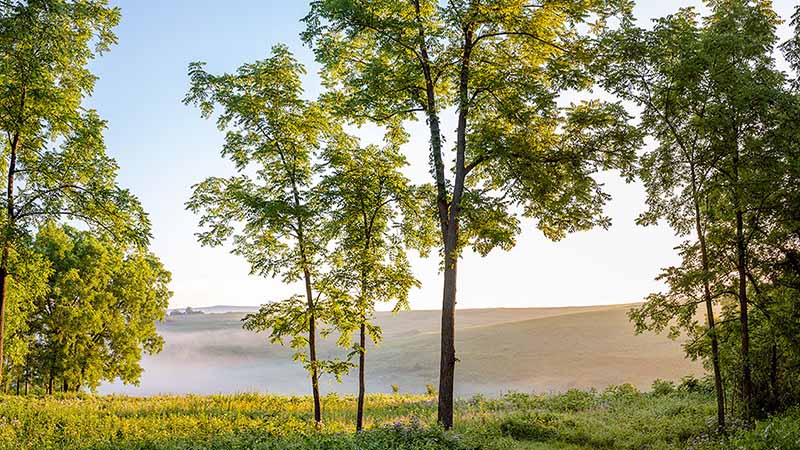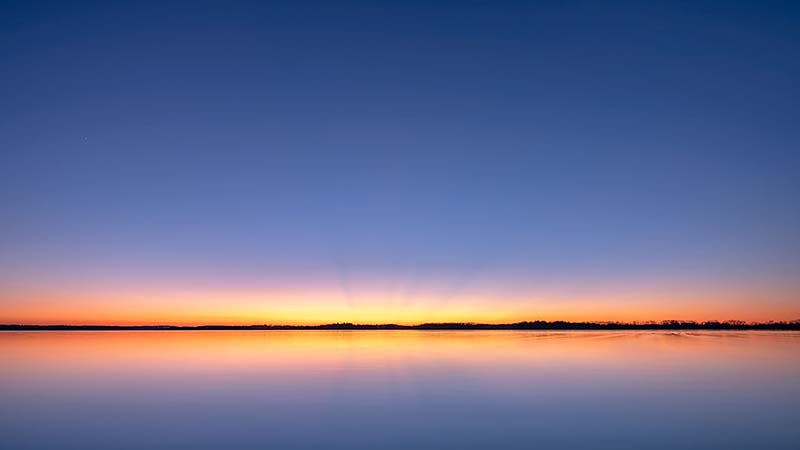WICCI’s Climate Working Group investigates Wisconsin’s changing climate using a blend of observations and models. We bring together climate experts to understand and assess Wisconsin’s past, present, and future climates.
Summary of Issues and Impacts
Wisconsin’s climate continues to change, and our citizens, businesses, and natural resources are feeling the impacts. In the years since WICCI released its 2011 Assessment Report, the WICCI Climate Working Group has continued to advance our understanding of climate change in Wisconsin and demonstrated that Wisconsin is becoming warmer and wetter.

Major Findings
Recent Weather
- The past two full decades (2000s and 2010s) have been Wisconsin’s warmest since accurate statewide records began in the 1890s. The first half of the 2020s decade (2020–24) has been even warmer, culminating in 2024 becoming Wisconsin’s warmest year on record.
- Based on county-scale maps of climate trends, winters are warming more rapidly than any other season, and nighttime temperatures are rising more than daytime temperatures. The winter of 2023–24 was Wisconsin’s warmest on record and featured record-low Great Lakes ice cover.
- The duration of time with air temperature below freezing (32 degrees Fahrenheit) has been declining. March is the month showing the largest decreasing trend since the mid-20th century, both in Wisconsin and nationally, essentially constituting a transition from being a winter month to a spring month in our state.
- The 2010s were Wisconsin’s wettest full decade on record by far, and 2019 was our state’s wettest year. During that decade, there were more than 20 daily rainfalls extreme enough to be considered “100-year events,” meaning that the chance of them happening is supposed to be only one percent in any given year.
- Our novel Extreme Weather Index reveals that Wisconsin has experienced unusually pronounced extreme weather in recent years, peaking during the 2010s. The largest increase in extreme weather since records began in 1895 has occurred across the southern third of Wisconsin, especially the south-central region.
Explore:
- Wisconsin Climate Chronicles: Blogs about recent Wisconsin weather including seasonal statistics, weather myths, and other climate news
- A New Index to Characterize Variations in Extreme Weather and its Application in Wisconsin (PowerPoint presentation)

Projected Weather
- By mid-century, the number of extremely hot days (90 degrees Fahrenheit or higher) and the frequency of extremely warm nights (low temperature of 70 degrees or above) in Wisconsin is likely to triple.
- Wisconsin is expected to become wetter overall in the future, particularly during winter and spring, but summer rainfall may decrease according to the most recent projections.
- Extreme precipitation events, particularly the most intense ones, are projected to become more frequent and intense.
- Flood magnitude and variability depend not only on extreme precipitation but also watershed-specific conditions such as soil moisture and snowpack, which are themselves affected by climate change. As a result, the impact of climate change on floods can vary significantly between different watersheds.
- Funding to support the Wisconsin State Climatology Office has enabled the Climate Working Group to greatly expand its products and activities.
Explore:
- Weathering the Changing Climate: What’s Happened and What’s Next? (PowerPoint presentation)
- Wisconsin Weather Weirdness: Understanding Wisconsin Climate Trends, Impacts, and Options for the Road Ahead (PowerPoint presentation)
- Wisconsin’s Changing Climate (PowerPoint presentation)
- Climate Change: The Growing Threat to Wisconsin (PowerPoint presentation)

Ongoing and Future Work
- We are creating detailed computer simulations (dynamically downscaled) of the Midwest and Great Lakes region to better understand how weather is changing. Our models focus on a small area (three kilometers) to better predict things like extreme rainfall events and the way the Great Lakes affect the weather.
- We are studying how climate change will affect future floods in the Midwest. Our study focuses on three Midwest watersheds to see how current ground conditions and extreme rainfall events work together to increase the risk for flooding.
- We are using our existing climate model to assess the risk of flooding in Wisconsin and Michigan. This detailed data will be a key part of the larger project for the Great Lakes Integrated Sciences and Assessments Center, which will help local groups and decision-makers in the region.
Explore:
Recommended Solutions/Strategies
1
Maintain support for the Wisconsin State Climatology Office as a trusted source for statewide climate data and translating climate information.
2
Maintain support for the Wisconsin Environmental Mesonet (Wisconet) to provide real-time weather and soil data in every county across the state.
3
Continue updating precipitation statistics for Wisconsin to use in defining climate and watershed land-use conditions, floodplain definitions, and infrastructure planning.
4
Assess the threat of increasing precipitation volatility and its impacts on Wisconsin.
5
Compare and contrast dynamically downscaled climate model projections with existing statistically downscaled projections to assess robustness and identify knowledge gaps.
6
Increase professional development for K-12 educators to foster climate science education among Wisconsin youth.
Environmental and Climate Justice Issues
Environmental and climate justice has emerged in recent years as an important aspect of climate change, and it needs to be accounted for when considering adaptation strategies. The 2021 WICCI Assessment Report cites various examples of injustice in terms of specific climate change impacts. Regarding climate change itself, some instances include:
Disproportionate Impacts
People who are less responsible for causing climate change due to their smaller individual or collective carbon emissions are often more affected than high polluters by its impacts.
Less Resilience
Even aside from contributions, some people and communities have less resilience to climate change impacts, due to resource disparities rooted in historical injustice.
Negative Health Effects
Underrepresented communities often live in closer proximity to pollution sources that cause climate change through carbon emissions and cause health problems though degraded air quality.
Explore:
Our Team
Stakeholders and Partners
- Dane County Office of Energy and Climate Change
- Great Lakes Integrated Sciences and Assessments Center
- Midwest Climate Adaptation Science Center
- Midwest Climate Collaborative
- Midwest Climate Partners
- Midwestern Regional Climate Center
- Northern Institute of Applied Climate Science
- University of Wisconsin-Madison Division of Extension
- University of Wisconsin-Madison Rural Partnerships Institute
- USDA Midwest Climate Hub
- Wisconsin Department of Health Services
- Wisconsin Department of Natural Resources
Members
- Steve Vavrus (chair), Senior Scientist, Center for Climatic Research, UW–Madison, sjvavrus@wisc.edu
- Mo Abbasian, postdoctoral research associate, UW–Madison
- Josh Bendorf, Outreach Specialist, Wisconsin State Climatology Office, UW–Madison
- Paul Buchmann, Postdoctoral Scientist, Wisconsin State Climatology Office, UW–Madison
- Ed Hopkins, Assistant State Climatologist, Wisconsin State Climatology Office, UW–Madison
- David Lorenz, Senior Scientist, Center for Climatic Research, UW–Madison
- Bridgette Mason, Assistant State Climatologist, Wisconsin State Climatology Office, UW–Madison
- Michael Notaro, Senior Scientist and Director, Center for Climatic Research, UW–Madison
- Amanda Schwabe, Outreach Specialist, Wisconsin State Climatology Office, UW–Madison
- Dan Vimont, Professor, Department of Atmospheric and Oceanic Sciences, UW–Madison
